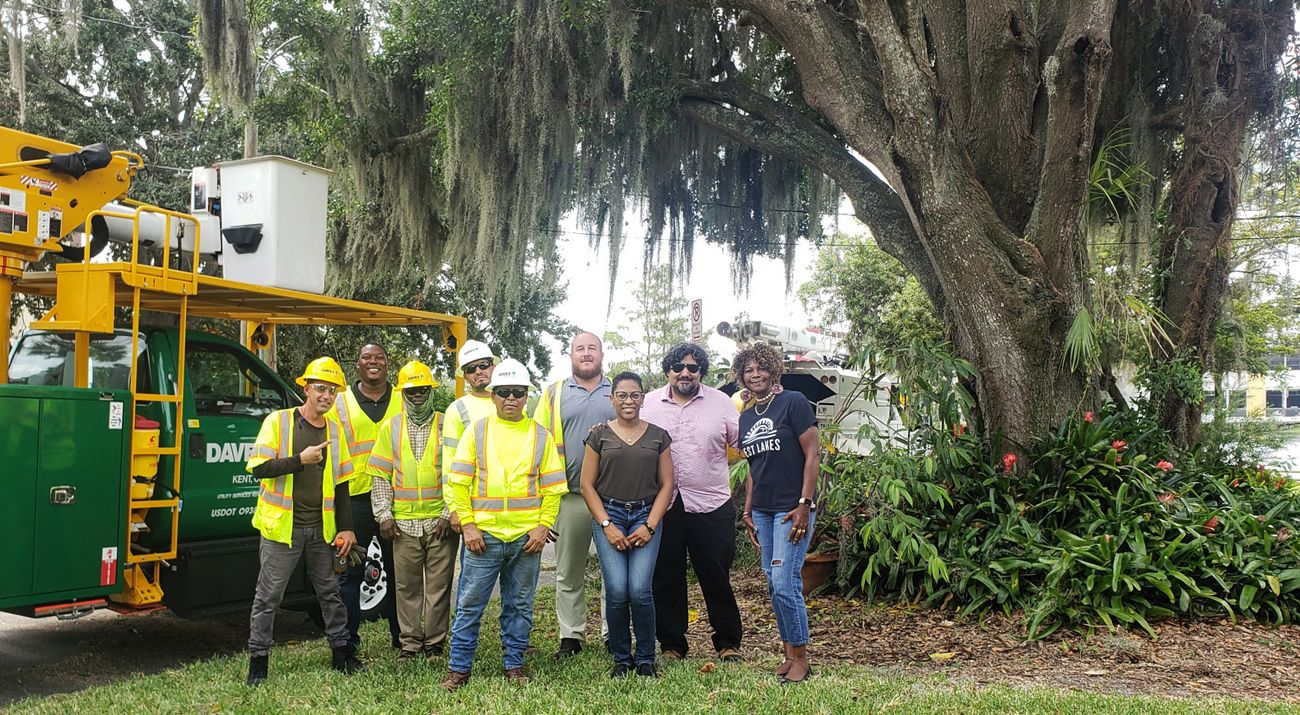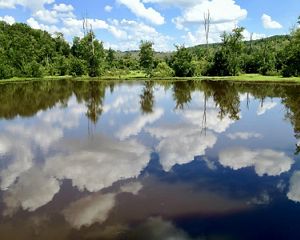
Orlando Metro Cities Program
Working with communities to improve urban life through conservation.
Orlando Metro Cities Program
Overview
Once lakes and pine forest wilderness, and then farms, ranches and citrus groves, today Central Florida is home to the Orlando Metropolitan area. Stretching across six counties—Brevard, Lake, Orange, Osceola, Seminole and Volusia—the Orlando metro area is a diverse and beautiful region with both natural spaces and growing urban development. As the fastest growing metro area in Florida and the third fastest-growing metro in the nation, the population of metropolitan Orlando is increasing and the urban footprint is expanding further into environmentally sensitive lands to meet the needs of ongoing growth.
Often as cities grow, natural systems degrade, greenspaces disappear, temperatures increase and communities become more vulnerable to climate change impacts. The Orlando Metro area is faced with the need to balance rapid development and controversial proposals that impact regional ecosystems, the habitats that help supply our drinking water and support iconic wildlife and biodiversity in Florida. The time is now to guide a bright future for the region, to ensure that valuable greenspaces and sustainable practices are at the forefront of urban planning.
TNC is committed to making that vision a reality, keeping nature in focus as a solution to challenges and a valued asset, so that both nature and people can thrive. We are focused on integrating conservation in urban planning to transform city landscapes for the benefit of people and nature, and to advance urban resilience.
But what exactly do we mean by urban conservation?
Urban conservation is the active management of the natural resources and systems of a city to preserve, maintain and restore their functions; deliver a wide array of benefits to protect biodiversity; and enhance the well-being of residents, while ideally prioritizing the needs of under-resourced and frontline communities. Urban conservation focuses on protecting nature for cities, thereby improving the functions of the systems on which cities rely, as well as improving the lives of people in cities.
TNC is playing an important role connecting scientists, decision makers, community members and nonprofit organizations in the Orlando Metro area so that, together, we can find solutions to development challenges and threats to natural ecosystems. Here at TNC, we know urban conservation has the potential to strengthen the bond between cities, nature and people by deploying nature-based solutions that protect biodiversity and improve the quality of modern urban life, while informing the next generation of environmental stewards.
Program Priorities
TNC has identified various areas in which we can lend our expertise and energies to the most impactful use. Our goals include efforts to:

Treesilience Project
Trees in urban areas provide many benefits that help alleviate urban environmental challenges. Trees reduce heat, provide shade, block wind and provide habitat. They also reduce flooding, capture and store carbon, boost physical and mental health and provide aesthetic value.
However, when a storm hits the Orlando metro area, severe winds and wind-born rain create hazards such as flooding and downed trees in inland and coastal areas across the region. Damage caused by uprooted or falling tree limbs is one of the most severe impacts of hurricanes and tropical storms—causing power outages, loss of property and infrastructure and even fatalities. And the loss of tree canopy reduces available shade and decreases heat and pollution absorption.
Local governments frequently encourage homeowners to prepare for hurricane season by trimming trees, but communities that are more vulnerable to, and disproportionately impacted by extreme weather events often lack the resources for preventive tree maintenance. This increases their risk of damage caused by unhealthy or dying trees.
Enter Treesilience, a national TNC initiative focused on creating a resilient tree canopy in urban areas. In Orlando, we are working in vulnerable communities to maintain mature trees, plant new ones and a long-term goal of recruiting youth from underrepresented backgrounds for jobs in urban forestry and conservation. Thanks to a generous grant from Walt Disney World Resort, Treesilience provides tree health assessment and maintenance, dead tree removal and replacement and new plantings of Florida-friendly shade and fruit trees to address heat and food insecurity concerns.
In an effort to support our goal to mitigate hazards and improve disaster preparedness, we are partnering with the Pine Hills Community Council, Infinite Zion Farms, IDEAS For Us, and Davey Tree Experts on the Treesilience project. Treesilience provides preventive tree maintenance for low-income homeowners in under-resourced communities and offers plantings of wind-resistant trees to restore tree canopy.
Conventionally, the notion of maintenance in many cities has focused on the built environment, specifically bridges, roads and power lines known as gray infrastructure. Treesilience draws attention to trees as a key part of natural infrastructure, which can be susceptible to costly failures, when not maintained. The Treesilience project emphasizes safeguarding our natural infrastructure, moving us toward our goal of building sustainable and resilient communities.

Orlando Development Facts
Facts about growth and development in the Orlando Metro area in Florida.
-
Central Florida Development Projections
Orange County is projected to be the fastest-growing County by 2030, while Osceola County will increase in population by more than 50%. Brevard County is projected to undergo concentrated development along the Indian River Lagoon with profound implications on natural lands and lagoon health.
-
Orlando Metro Natural Areas
The Orlando Metro area is comprised of multiple regional, state, and national parks including the Wekiwa Springs State Park, Blue Spring State Park, Charles H. Bronson State Forest, Hal Scott Regional Preserve and Park, Lake Woodruff National Wildlife Refuge, and Canaveral National Seashore.

The Monarch Initiative
Launched in 2018 with the support of Full Sail University, The Monarch Initiative is focused on the iconic and imperiled monarch butterfly, a symbol of the many conservation challenges that pollinators and wildlife, natural systems and people face in Florida and around the globe. The unique program aims to increase awareness of the value of nature in our lives and encourage conservation action by educating the Central Florida community on the importance of pollinators and healthy natural systems through outreach and collaboration. This project moves TNC toward our goal to connect people with nature and protect biodiversity.
Why Monarchs?
The iconic monarch butterfly’s recognizable and beautiful appearance make it the perfect pollinator to start a conversation about the connections between people and nature.
Monarchs are known for their impressive multigenerational migration, spanning from Mexico to Canada. However, they have suffered a severe decline in population—decreasing from approximately one billion in 1996 to only about 100 million in 2016.
The monarch’s decline highlights the important role insects, pollinators, and natural systems play in our daily lives and the urgent need for protection efforts. It is thanks to pollinators that we have honey, potatoes, tree fruits, berries, grapes, avocados, coffee, tomatoes, chocolate, sugarcane, agave and other dietary staples.
Florida is home to both migratory and non-migratory populations of monarchs. This is believed to be caused, at least in part, by abundant evergreen milkweed. Milkweed is the only plant that monarch caterpillars can eat, and the only plant upon which adult monarchs will lay their eggs, making its prevalence critical to the monarch’s survival.
Visit the Murals in Orlando
A series of murals created by Ink Dwell studio as part of their Migrating Mural series highlight threatened and endangered wildlife along the migration corridors they share with people. These murals expose the public to endangered, elusive and transient animals that may otherwise go unseen.

The premier central Florida mural, titled Milkweed Galaxy, features monarchs painted in exacting detail and spectacular color and appears on the campus of Full Sail University in Winter Park, Florida. The mural appears across the entire front façade of Full Sail Live 3 located at 3150 University Boulevard in Winter Park. It is surrounded by butterfly-friendly landscaping. The mural is highly visible to the public from University Boulevard, where approximately 40,000 viewers pass by each day.

The second mural, titled Midnight Dream, is located in downtown Orlando across the entire rear wall of 520 South Magnolia Avenue, next to the Dr. Phillips Center for the Performing Arts and across the street from City Hall. Facing Orange Avenue, the arresting and dramatic mural highlights monarch butterflies among their essential milkweed.

What can I do to Help Monarchs?
- Visit one of the Migrating Murals in Florida or beyond.
- Explore nature at a one of our two preserves in Central Florida—Disney Wilderness Preserve and Tiger Creek Preserve. Here you can experience old Florida restored to its natural beauty just a short drive from Orlando.
- Explore TNC's work to support monarchs in Oklahoma and Nevada.
- Plant a pollinator garden on your lawn or patio.
- Learn about the Monarch Joint Venture, a partnership of federal and state agencies, non-governmental organizations, businesses and academic programs working together to protect the monarch migration across the United States.
- Support science education in your schools. Nature Lab provides standards-aligned curriculum to help students learn the science behind how nature works for us and how we can help keep it running strong.
- Take action and advocate to keep nature on the federal agenda. Share your concern with your elected officials and urge them to act to protect people and nature.
- Encourage your friends, family and community to speak up for nature. Share your commitment. Ask people to join you. Speak up for science-based solutions that support nature and people.
- Support our work in Florida and around the globe.

